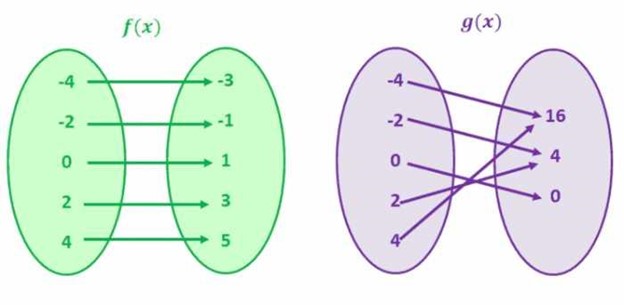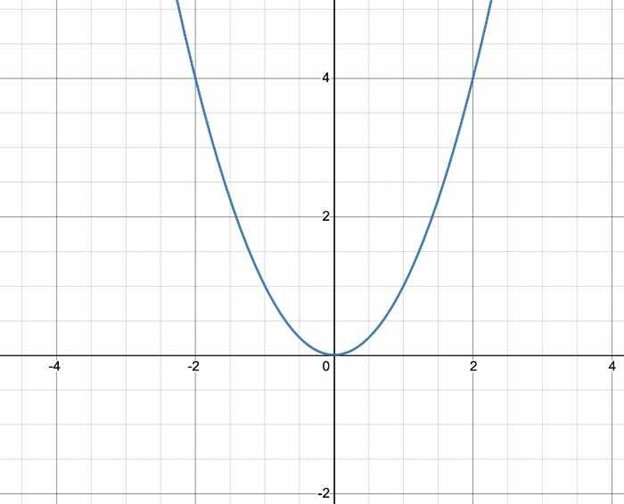One to One Functions - Graph, Examples | Horizontal Line Test
What is a One to One Function?
A one-to-one function is a mathematical function where each input correlates to a single output. In other words, for each x, there is only one y and vice versa. This implies that the graph of a one-to-one function will never intersect.
The input value in a one-to-one function is known as the domain of the function, and the output value is the range of the function.
Let's look at the examples below:

For f(x), each value in the left circle corresponds to a unique value in the right circle. In the same manner, every value on the right side correlates to a unique value in the left circle. In mathematical terms, this means that every domain holds a unique range, and every range holds a unique domain. Therefore, this is a representation of a one-to-one function.
Here are some other examples of one-to-one functions:
-
f(x) = x + 1
-
f(x) = 2x
Now let's examine the second picture, which exhibits the values for g(x).
Be aware of the fact that the inputs in the left circle (domain) do not own unique outputs in the right circle (range). Case in point, the inputs -2 and 2 have identical output, i.e., 4. In conjunction, the inputs -4 and 4 have identical output, i.e., 16. We can discern that there are equivalent Y values for many X values. Therefore, this is not a one-to-one function.
Here are additional representations of non one-to-one functions:
-
f(x) = x^2
-
f(x)=(x+2)^2
What are the qualities of One to One Functions?
One-to-one functions have the following characteristics:
-
The function owns an inverse.
-
The graph of the function is a line that does not intersect itself.
-
The function passes the horizontal line test.
-
The graph of a function and its inverse are identical with respect to the line y = x.
How to Graph a One to One Function
When trying to graph a one-to-one function, you will need to determine the domain and range for the function. Let's study a simple representation of a function f(x) = x + 1.

As soon as you know the domain and the range for the function, you ought to graph the domain values on the X-axis and range values on the Y-axis.
How can you evaluate whether or not a Function is One to One?
To indicate if a function is one-to-one, we can use the horizontal line test. Immediately after you graph the graph of a function, draw horizontal lines over the graph. In the event that a horizontal line intersects the graph of the function at more than one spot, then the function is not one-to-one.
Due to the fact that the graph of every linear function is a straight line, and a horizontal line will not intersect the graph at more than one point, we can also reason that all linear functions are one-to-one functions. Don’t forget that we do not leverage the vertical line test for one-to-one functions.
Let's study the graph for f(x) = x + 1. Once you chart the values to x-coordinates and y-coordinates, you have to review if a horizontal line intersects the graph at more than one point. In this example, the graph does not intersect any horizontal line more than once. This indicates that the function is a one-to-one function.

On the contrary, if the function is not a one-to-one function, it will intersect the same horizontal line more than once. Let's look at the graph for the f(y) = y^2. Here are the domain and the range values for the function:

Here is the graph for the function:

In this instance, the graph intersects numerous horizontal lines. For instance, for either domains -1 and 1, the range is 1. Additionally, for both -2 and 2, the range is 4. This implies that f(x) = x^2 is not a one-to-one function.
What is the inverse of a One-to-One Function?
As a one-to-one function has just one input value for each output value, the inverse of a one-to-one function is also a one-to-one function. The opposite of the function basically reverses the function.
For Instance, in the case of f(x) = x + 1, we add 1 to each value of x in order to get the output, i.e., y. The opposite of this function will deduct 1 from each value of y.
The inverse of the function is f−1.
What are the qualities of the inverse of a One to One Function?
The properties of an inverse one-to-one function are identical to all other one-to-one functions. This implies that the inverse of a one-to-one function will possess one domain for each range and pass the horizontal line test.
How do you determine the inverse of a One-to-One Function?
Finding the inverse of a function is very easy. You simply have to change the x and y values. For example, the inverse of the function f(x) = x + 5 is f-1(x) = x - 5.

Considering what we learned before, the inverse of a one-to-one function undoes the function. Because the original output value required adding 5 to each input value, the new output value will require us to deduct 5 from each input value.
One to One Function Practice Examples
Consider the subsequent functions:
-
f(x) = x + 1
-
f(x) = 2x
-
f(x) = x2
-
f(x) = 3x - 2
-
f(x) = |x|
-
g(x) = 2x + 1
-
h(x) = x/2 - 1
-
j(x) = √x
-
k(x) = (x + 2)/(x - 2)
-
l(x) = 3√x
-
m(x) = 5 - x
For every function:
1. Identify if the function is one-to-one.
2. Chart the function and its inverse.
3. Figure out the inverse of the function numerically.
4. Indicate the domain and range of every function and its inverse.
5. Employ the inverse to determine the value for x in each formula.
Grade Potential Can Help You Learn You Functions
If you find yourself facing difficulties trying to learn one-to-one functions or similar concepts, Grade Potential can connect you with a private instructor who can help. Our Cleveland math tutors are skilled professionals who help students just like you advance their skills of these concepts.
With Grade Potential, you can learn at your own pace from the comfort of your own home. Schedule a meeting with Grade Potential today by calling (216) 616-1177 to find out more about our teaching services. One of our consultants will call you to better ask about your needs to provide you with the best teacher for you!




